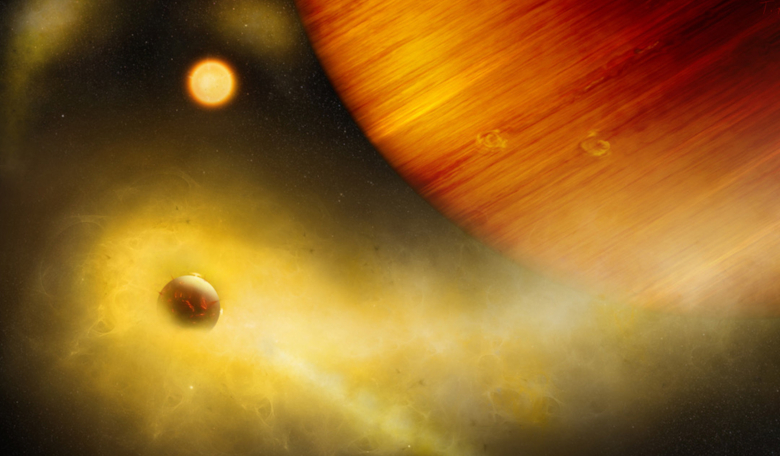New research by a team of astronomers at Bern University, Switzerland have potentially found an active exomoon that is an extreme version of Jupiter’s moon Io – a sodium spewing, lava flowing hot body that is hiding 550 light-years away in an exoplanet system known as WASP-49b.
Io, the innermost of Jupiter’s four Galilean moons, is not only pretty big – it is the fourth-largest moon in the solar system – it is also the most geologically active object in the Solar System.
This remarkable world is dotted with more than 100 mountains, some of which have peaks taller than Mount Everest and numerous extensive lava flows, several more than 500 kilometres (300 miles) in length that have erupted out from the 400+ volcanoes strewn across its surface.
The fallout from plumes of sulphur and sulphur dioxide belched out from the volcanoes, leaves Io’s surface a mottled canvas of yellow, red, white and green, intermingled with patches of black.
Constant volcanism, a lack of water and intense radiation make Io an unlikely destination for life, unlike it’s ice-rich neighbours. While Io might be largely uninhabitable, the volcanism responsible for many of Io’s unique features has helped astronomers identify similar signs of geological activity venting from an otherwise hidden exo-Io moon.
Astronomers have not yet discovered a rocky moon beyond our solar system because extrasolar satellites, or exomoons as they are generally called, are normally too small to be detected by traditional telescopic searches. There have been recent hints of a discovery, but so far conclusive proof of an exomoon has evaded detection and scientists are leaning towards different methods to try and capture evidence of their existence.
One such team, headed by Apurva Oza, postdoctoral fellow at the Physics Institute of the University of Bern along with colleagues, has been comparing gas signatures from Io, specifically sodium and potassium, with a suite of five suitable candidate exomoons ripe for further exploration.
And they think they have found their first one; an exo-Io orbiting a hot Saturn-mass planet known as WASP-49b. Wasp 49-b was first discovered in 2011 and subsequent studies of its atmosphere showed that it contained sodium.
Previous research into large amounts of sodium emanating from an exoplanet, pointed to either a ring of material that was being irradiated or more tantalising, signs that a exomoon was lurking unseen in the vicinity.
“Sodium and potassium lines are quantum treasures to us astronomers because they are extremely bright,” says Oza. “The vintage street lamps that light up our streets with yellow haze, is akin to the gas we are now detecting in the spectra of a dozen exoplanets.”
Of the five systems Oza and colleagues studied, Wasp 49-b stood out due to sodium gas detected at an anomalously high-altitude. “The neutral sodium gas is so far away from the planet that it is unlikely to be emitted solely by a planetary wind,” says Oza.
While it doesn’t categorically mean that Wasp 49-b is harbouring an exo-Io moon, the signs are promising. “It would be a dangerous volcanic world with a molten surface of lava, a lunar version of close-in Super Earths like 55 Cancri-e” says Oza.
More remarkable is that although the possible exomoon orbits a hot giant planet, Wasp 49-b, this in turn races once around its host star in less than three days. This set-up might seem like a recipe for disaster, but research conducted by scientists at the University of Virginia in 2006 calculated that such a compact system of three bodies: star, close-in giant planet and moon, can be stable over billions of years.
“The enormous tidal forces in such a system are the key to everything,” explains Oza, but a discovery of this type needs more data. “We need to find more clues,” Oza admits. To this end, the team are relying on further observations with ground-based and space-based instruments to ascertain whether the signs really do point to the first detection of an exo-Io or whether it’s something a little less exciting such as an exoplanet surrounded by a ring of ionised gas.











